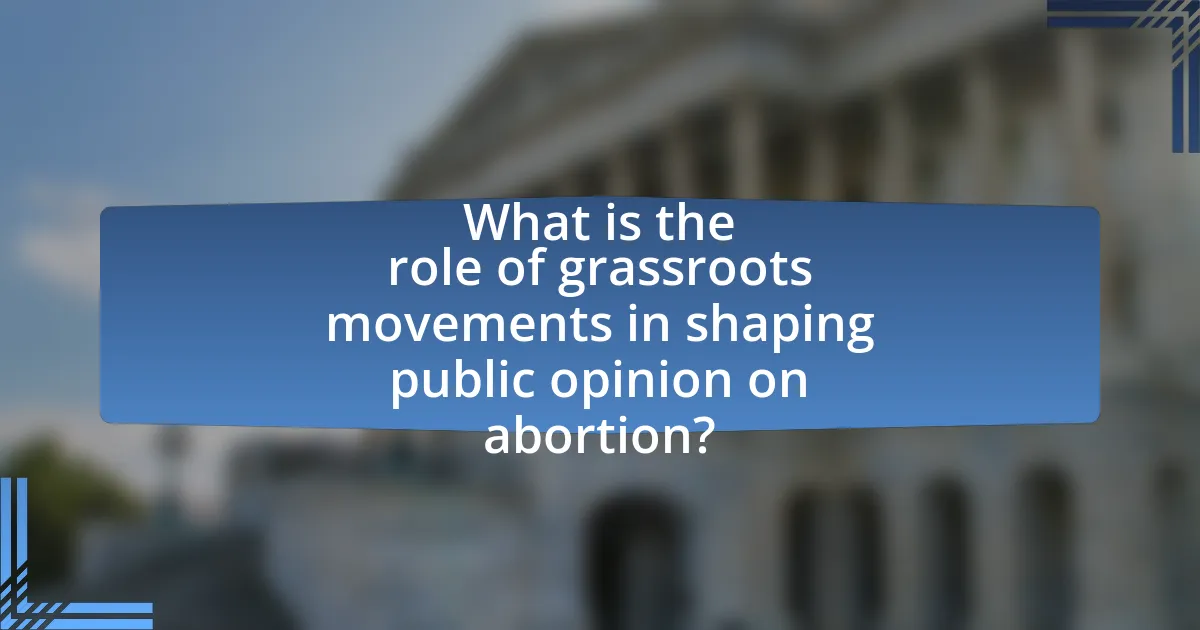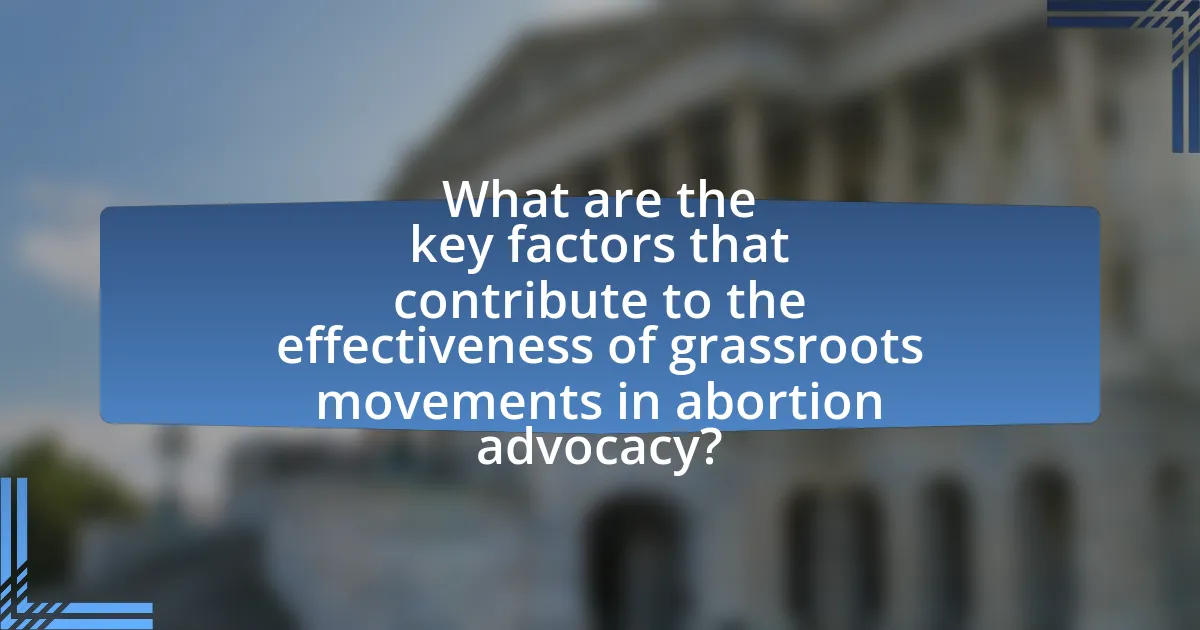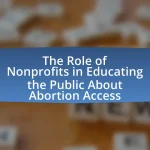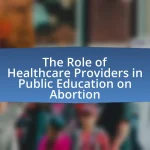Grassroots movements play a vital role in shaping public opinion on abortion by mobilizing communities, raising awareness, and influencing political discourse. These movements utilize strategies such as community organizing, social media campaigns, and educational outreach to engage the public and foster dialogue around reproductive rights. Research indicates that grassroots activism can significantly impact public attitudes, with increased visibility leading to greater support for abortion rights. Additionally, the historical context of feminist movements and the collaboration with established organizations enhance the effectiveness of grassroots efforts in advocating for reproductive health policies. This article explores the strategies, challenges, and successes of grassroots movements in the ongoing abortion debate.

What is the role of grassroots movements in shaping public opinion on abortion?
Grassroots movements play a crucial role in shaping public opinion on abortion by mobilizing communities, raising awareness, and influencing political discourse. These movements often consist of local activists who advocate for reproductive rights, organize protests, and engage in educational campaigns that highlight personal stories and experiences related to abortion. For instance, organizations like Planned Parenthood and the Women’s March have effectively utilized grassroots strategies to amplify voices and create a sense of urgency around reproductive health issues. Research indicates that grassroots activism can significantly impact public attitudes; a study published in the American Journal of Public Health found that increased visibility of grassroots campaigns correlates with more supportive public opinions on abortion rights.
How do grassroots movements influence public perception of abortion?
Grassroots movements significantly influence public perception of abortion by mobilizing community engagement and fostering dialogue around the issue. These movements often utilize social media platforms to disseminate information, share personal stories, and challenge prevailing narratives, which can shift public attitudes. For instance, campaigns like “Shout Your Abortion” have encouraged individuals to openly discuss their experiences, thereby normalizing the conversation around abortion and reducing stigma. Research indicates that increased visibility and personal testimonies from grassroots efforts can lead to greater empathy and understanding among the public, ultimately affecting legislative outcomes and societal norms regarding abortion.
What strategies do grassroots movements employ to raise awareness about abortion issues?
Grassroots movements employ strategies such as community organizing, social media campaigns, and educational outreach to raise awareness about abortion issues. Community organizing involves mobilizing local individuals to participate in events, rallies, and discussions that highlight the importance of reproductive rights. Social media campaigns leverage platforms like Twitter and Instagram to disseminate information quickly, engage younger audiences, and create viral content that raises awareness. Educational outreach includes workshops, seminars, and distribution of informational materials that inform the public about abortion rights, access, and the implications of legislation. These strategies have proven effective; for instance, the Women’s March in 2017 galvanized millions globally, significantly increasing public discourse on women’s rights, including abortion.
How do grassroots movements mobilize community support for abortion rights?
Grassroots movements mobilize community support for abortion rights by fostering local engagement and creating a sense of collective identity among supporters. These movements often utilize community organizing strategies, such as door-to-door canvassing, public demonstrations, and social media campaigns, to raise awareness and educate the public about abortion rights. For instance, organizations like Planned Parenthood and the Women’s March have effectively mobilized thousands of individuals through coordinated events and advocacy efforts, demonstrating the power of grassroots activism. Research indicates that grassroots efforts can significantly influence public opinion; a study by the Pew Research Center found that local activism correlates with increased support for abortion rights in communities where these movements are active.
Why are grassroots movements significant in the abortion debate?
Grassroots movements are significant in the abortion debate because they mobilize community engagement and influence public opinion. These movements often arise from local concerns and provide a platform for individuals to express their views, thereby shaping the narrative around abortion rights and access. For instance, organizations like Planned Parenthood and local advocacy groups have successfully organized rallies and campaigns that highlight personal stories and experiences, which resonate with the public and policymakers. Research indicates that grassroots efforts can lead to increased awareness and support for reproductive rights, as seen in the surge of activism following legislative changes in various states. This localized activism not only raises awareness but also pressures lawmakers to consider constituents’ opinions, making grassroots movements a crucial element in the ongoing abortion debate.
What historical context has shaped the emergence of grassroots movements in abortion advocacy?
The historical context that has shaped the emergence of grassroots movements in abortion advocacy includes the feminist movements of the 1960s and 1970s, which fought for women’s rights and reproductive autonomy. These movements highlighted the need for legal access to abortion as a fundamental aspect of women’s health and equality. The landmark Supreme Court decision in Roe v. Wade in 1973 further galvanized grassroots efforts, as it legalized abortion nationwide and prompted both support and opposition, leading to the formation of various advocacy groups. Additionally, the backlash against reproductive rights in the 1980s and 1990s, including the rise of the pro-life movement, spurred grassroots mobilization among abortion rights advocates to defend and expand access to reproductive healthcare. This historical interplay of legal, social, and political factors has been crucial in shaping the strategies and goals of grassroots movements in abortion advocacy.
How do grassroots movements differ from traditional advocacy organizations in their approach to abortion?
Grassroots movements differ from traditional advocacy organizations in their approach to abortion by emphasizing community engagement and direct action rather than formal lobbying and institutional influence. Grassroots movements often mobilize individuals at the local level, fostering personal connections and collective action to raise awareness and drive change, as seen in campaigns like “Women’s March” which galvanized widespread participation. In contrast, traditional advocacy organizations typically focus on policy change through established channels, such as lobbying government officials and engaging in legal battles, exemplified by groups like Planned Parenthood, which prioritize legislative advocacy and funding. This distinction highlights how grassroots movements prioritize grassroots mobilization and community-driven initiatives, while traditional organizations rely on structured advocacy methods to influence abortion policy.

What are the key factors that contribute to the effectiveness of grassroots movements in abortion advocacy?
The key factors that contribute to the effectiveness of grassroots movements in abortion advocacy include community engagement, strategic messaging, and coalition-building. Community engagement fosters a sense of ownership and mobilizes local support, as seen in the success of organizations like Planned Parenthood, which actively involve community members in advocacy efforts. Strategic messaging ensures that the movement resonates with diverse audiences, utilizing social media platforms to amplify voices and share personal stories, which has been shown to increase public empathy and support for abortion rights. Coalition-building with other social justice movements enhances resources and visibility, exemplified by the collaboration between reproductive rights advocates and broader human rights organizations, which strengthens the overall impact of the advocacy efforts.
How does social media play a role in grassroots movements focused on abortion?
Social media significantly enhances grassroots movements focused on abortion by facilitating rapid information dissemination and mobilization of supporters. Platforms like Twitter and Facebook allow activists to share personal stories, educational content, and calls to action, which can quickly reach a wide audience. For instance, the #ShoutYourAbortion campaign utilized social media to normalize conversations around abortion, leading to increased visibility and support for reproductive rights. Additionally, studies show that social media engagement can lead to higher levels of public awareness and activism, as seen in the surge of participation during events like the Women’s March, which was heavily promoted online.
What platforms are most effective for grassroots movements in promoting abortion rights?
Social media platforms, particularly Facebook, Twitter, and Instagram, are the most effective for grassroots movements in promoting abortion rights. These platforms enable rapid dissemination of information, mobilization of supporters, and engagement in discussions, which are crucial for raising awareness and influencing public opinion. For instance, a study by the Pew Research Center found that 69% of adults in the U.S. use Facebook, making it a powerful tool for organizing events and sharing personal stories related to abortion rights. Additionally, Twitter’s real-time communication allows movements to respond quickly to legislative changes and public discourse, while Instagram’s visual storytelling can effectively convey emotional narratives that resonate with younger audiences.
How do online campaigns translate into offline activism for abortion issues?
Online campaigns translate into offline activism for abortion issues by mobilizing supporters, raising awareness, and facilitating organization for events. These campaigns often utilize social media platforms to disseminate information, create a sense of community, and encourage individuals to participate in protests, rallies, and advocacy efforts. For instance, the #ShoutYourAbortion campaign effectively encouraged individuals to share personal stories, which not only destigmatized abortion but also led to increased participation in local activism, as evidenced by a surge in attendance at related events following the campaign’s launch. This demonstrates that online engagement can significantly enhance offline actions, fostering a more active and informed public discourse surrounding abortion rights.
What challenges do grassroots movements face in shaping public opinion on abortion?
Grassroots movements face significant challenges in shaping public opinion on abortion, primarily due to misinformation and polarization. Misinformation campaigns often spread false narratives about abortion, which can skew public perception and create confusion. Additionally, the issue of abortion is highly polarized, with entrenched views on both sides making it difficult for grassroots movements to find common ground and effectively communicate their messages. According to a 2020 study by the Pew Research Center, 61% of Americans believe that abortion should be legal in all or most cases, yet the intense opposition from anti-abortion groups can overshadow these views, complicating efforts to shift public opinion. Furthermore, grassroots movements often lack the financial resources and media access that larger organizations possess, limiting their ability to reach wider audiences and amplify their messages.
How do political opposition and legal barriers impact grassroots efforts?
Political opposition and legal barriers significantly hinder grassroots efforts by limiting access to resources, restricting messaging, and creating an environment of fear and uncertainty. For instance, in the context of abortion rights, states with stringent laws often impose regulations that make it difficult for grassroots organizations to mobilize support, such as requiring permits for protests or limiting the distribution of informational materials. Research from the Guttmacher Institute indicates that 27 states have enacted laws that impose various restrictions on abortion access, which directly affects the ability of grassroots movements to advocate effectively. Additionally, political opposition can lead to increased scrutiny and backlash against activists, discouraging participation and diminishing the overall impact of grassroots initiatives.
What strategies can grassroots movements use to overcome these challenges?
Grassroots movements can overcome challenges by employing strategies such as building coalitions, utilizing social media for outreach, and engaging in community education. Building coalitions allows diverse groups to unite, amplifying their collective voice and resources, which has been effective in various social movements, including those advocating for abortion rights. Utilizing social media platforms enables grassroots movements to reach wider audiences quickly and efficiently, as evidenced by the viral campaigns surrounding reproductive rights that have mobilized support and awareness. Engaging in community education fosters informed discussions, empowering individuals to advocate for their rights and influencing public opinion, as seen in successful campaigns that have shifted perceptions on abortion.

How do grassroots movements collaborate with other organizations to influence abortion policy?
Grassroots movements collaborate with other organizations to influence abortion policy by forming coalitions that amplify their advocacy efforts. These coalitions often include non-profit organizations, healthcare providers, and legal advocacy groups, which work together to share resources, mobilize supporters, and coordinate campaigns. For instance, the Women’s March and Planned Parenthood have partnered to organize rallies and educational initiatives that raise awareness about reproductive rights, effectively reaching a broader audience. Research indicates that such collaborations can enhance the visibility of issues and increase public engagement, as seen in the 2017 Women’s March, which drew millions and significantly impacted public discourse on abortion policy.
What partnerships are most effective for grassroots movements in the abortion landscape?
Coalitions with reproductive health organizations, local community groups, and advocacy networks are the most effective partnerships for grassroots movements in the abortion landscape. These collaborations enhance resource sharing, amplify messaging, and mobilize community support. For instance, partnerships with organizations like Planned Parenthood provide access to medical expertise and educational resources, while alliances with local community groups foster grassroots engagement and outreach. Research indicates that grassroots movements that effectively collaborate with established organizations can increase their impact, as seen in the 2016 “Women’s March,” which united various groups to advocate for reproductive rights, demonstrating the power of collective action in shaping public opinion on abortion.
How do coalitions enhance the impact of grassroots movements on public opinion?
Coalitions enhance the impact of grassroots movements on public opinion by amplifying their reach and unifying diverse voices. When grassroots organizations collaborate, they pool resources, share networks, and combine messaging, which increases visibility and credibility. For instance, the coalition of various reproductive rights groups during the 2016 election mobilized a broader audience, resulting in increased voter engagement and awareness about abortion issues. This collective effort led to a significant shift in public opinion, as evidenced by polls indicating rising support for reproductive rights during that period.
What role do local organizations play in supporting national grassroots initiatives on abortion?
Local organizations play a crucial role in supporting national grassroots initiatives on abortion by mobilizing community members, providing resources, and amplifying local voices. These organizations often serve as the frontline advocates, educating the public about reproductive rights and connecting individuals to national campaigns. For example, local groups can organize events, distribute informational materials, and facilitate discussions that align with national initiatives, thereby increasing awareness and engagement at the grassroots level. Research indicates that grassroots movements, supported by local organizations, significantly influence public opinion and policy changes regarding abortion, as seen in various states where local activism has led to increased access to reproductive health services.
What lessons can be learned from successful grassroots movements in the abortion debate?
Successful grassroots movements in the abortion debate demonstrate the importance of community engagement and strategic messaging. These movements effectively mobilize local supporters, creating a sense of ownership and urgency around the issue. For instance, the Women’s March in 2017 galvanized millions to advocate for reproductive rights, showcasing how collective action can influence public discourse and policy. Additionally, successful movements often utilize social media to amplify their message, reaching broader audiences and fostering solidarity among diverse groups. Research indicates that grassroots campaigns can shift public opinion significantly; for example, a study by the Pew Research Center found that sustained advocacy efforts can lead to increased support for abortion rights over time. These lessons highlight the power of grassroots organizing in shaping societal attitudes and legislative outcomes regarding abortion.
What best practices can be adopted by new grassroots movements focused on abortion advocacy?
New grassroots movements focused on abortion advocacy should adopt best practices such as building a strong coalition, utilizing social media effectively, and engaging in community education. Building a coalition with established organizations enhances credibility and resource sharing, which is crucial for mobilizing support. Effective use of social media platforms allows for rapid dissemination of information and engagement with a broader audience, as studies show that 69% of adults in the U.S. use social media, making it a vital tool for advocacy. Community education initiatives, such as workshops and informational sessions, empower individuals with knowledge about reproductive rights and available services, fostering informed advocacy. These practices collectively strengthen grassroots movements and enhance their impact on public opinion regarding abortion.
How can grassroots movements measure their impact on public opinion regarding abortion?
Grassroots movements can measure their impact on public opinion regarding abortion through surveys, social media analytics, and public engagement metrics. Surveys can quantify shifts in attitudes by comparing pre- and post-campaign responses, revealing changes in public sentiment. For instance, a study by the Pew Research Center found that targeted outreach efforts can significantly influence opinions, as evidenced by a 10% increase in support for abortion rights following a grassroots campaign. Social media analytics provide insights into engagement levels, sentiment analysis, and reach, allowing movements to assess how effectively their messaging resonates with the public. Additionally, tracking participation in events and community discussions can indicate increased awareness and support, further validating the movement’s influence on public opinion.
What practical steps can individuals take to support grassroots movements in abortion advocacy?
Individuals can support grassroots movements in abortion advocacy by volunteering time and skills to local organizations focused on reproductive rights. Engaging in activities such as organizing events, participating in campaigns, or providing administrative support directly contributes to the movement’s effectiveness. Additionally, individuals can donate funds to these organizations, which often rely on financial support to sustain their operations and outreach efforts.
Furthermore, spreading awareness through social media platforms amplifies the message and reaches a broader audience, fostering community engagement. Research indicates that grassroots movements significantly influence public opinion; for instance, a study by the Pew Research Center found that increased visibility of advocacy efforts correlates with shifts in public attitudes toward abortion rights. By taking these practical steps, individuals can play a crucial role in advancing the goals of grassroots movements in abortion advocacy.


